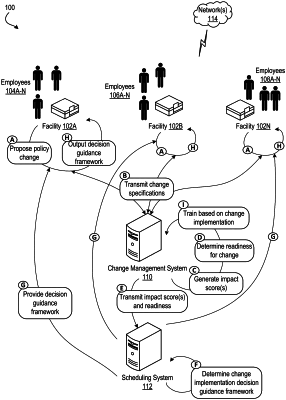| CPC G06Q 10/06311 (2013.01) | 20 Claims |

|
1. A method for managing and scheduling changes across an organization, the method comprising:
receiving, at a change management computer system, a request to implement a proposed change for a facility within an organization, wherein the request includes parameters for the proposed change;
determining, by the change management computer system, a change score for the proposed change that quantifies a magnitude of impact for the proposed change on the facility within the organization, wherein the determining is performed based on applying a computer-executed model to the parameters for the proposed change, wherein determining the change score comprises:
calculating a technology metric based on the parameters for the proposed change and the model, wherein the technology metric quantifies a technology impact on the facility for the proposed change, wherein the model is used to evaluate and quantify the technology impact comprising one or more technology fixes and new technology to be deployed to determine the technology metric;
calculating a data metric based on the parameters for the proposed change and the model, wherein the data metric quantifies a data impact on the facility for the proposed change, wherein the model is used to evaluate and quantify the data impact comprising one or more data reporting and data visualization changes to be deployed to determine the data metric; and
combining the technology metric and the data metric to determine the change score;
determining, by the change management computer system and using the computer-executed model, a readiness metric for the facility, wherein the readiness metric quantifies a current ability of the facility to implement the proposed change based on current environmental conditions, recorded performance data for the facility indicating past performance by the facility with regard to previous changes, and a current workforce assessment for the facility;
accessing, from a change management database system, data records identifying other changes that are currently scheduled to be performed by the facility over a plurality of time periods, wherein the data records include other change scores for the other changes that quantify magnitudes of impact for the other changes on the facility;
determining, by the change management computer system and using the computer-executed model, a plurality of scheduled change scores for the facility within the organization for the plurality of time periods based, at least in part, on the other changes scores for the other changes scheduled for the facility over the plurality of time periods, wherein the plurality of schedule scheduled change scores indicate, for each of the plurality of time periods, an aggregate magnitude of impact on the facility for the other changes that are already scheduled for the facility;
selecting, by the change management computer system, one or more time periods from the plurality of time periods as being suitable for scheduling the proposed change for the facility based on (i) the readiness metric for the facility, (ii) identifying a scheduled change score amongst the plurality of scheduled change scores that is less than a first threshold value and (iii) determining that combining the identified schedule change score with the change score for the proposed change would not cause the identified scheduled change score to exceed a second threshold value;
generating, by the change management computer system, a decision guidance framework including instructions to implement the proposed change during the one or more time periods;
outputting, by the change management computer system, the decision guidance framework; and
iteratively training, by the change management computer system, the computer-executed model to dynamically adjust the change score for the proposed change and the readiness metric for the facility, wherein the iterative training is based at least in part on (i) the data records identifying the other changes that are currently scheduled and (ii) user input received by the change management system in response to outputting the decision guidance framework, wherein the user input comprises information about an actual implementation of the proposed change for the facility.
|